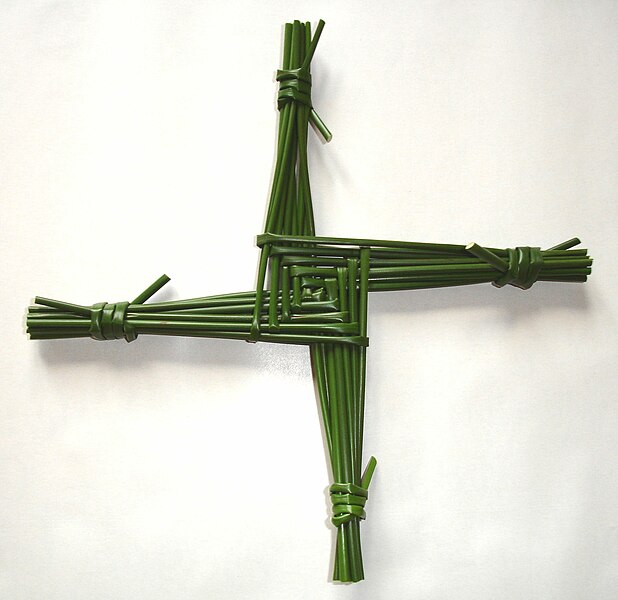
St Bride's Cross
One of the great Irish saints, and patron of those powerful Scottish Lords, the Douglas's, Bride was born at Faughart near Dundalk, County Louth,
Ireland. Faughart Church was founded by Saint Moninne in her honour and the old well, adjoining the ruined church there still attracts pilgrims.Because of the dubious historicity of the earliest accounts of
her life, there is mucho debate as to the authenticity of her biographies. Allegedly her parents were Dubhthach, a pagan chieftain of Leinster, and Brocca, a Christian Pict and slave, baptised by Saint Patrick. Some accounts suggest that her father was from Lusitania,
kidnapped by Irish pirates and brought to Ireland to as a slave, rather like Saint Patrick. I like the idea of her humbler origins myself. A freed slave made mighty by the overshadowing of the Holy Spirit. Fitting for the woman know as "the Mary of the Gaels".
St Bride was famous for her generosity to the poor. According
to one tale, as a child, she once gave away her mother's entire store of
butter. The butter was then replaced in answer to her prayers. She was allegedly "accidentally" ordained bishop, by one or other of the bishops Mel (d. 487) or Mac-Caille (d. c.489), probably being in Mág Tulach (Fartullagh, Co. Westmeath).
Mel also granted her abbatial powers. She followed Saint Mel into the
Kingdom of Teathbha (sections of modern Meath,
Westmeath and Longford) in about 468.
Bride's small oratory at Kildare became a centre of
religion and learning and eventually a cathedral city. She founded
two monastery's, one for men, and the other for women, and
appointed Saint Conleth as spiritual pastor of them. It has been frequently (mis) stated that she gave canonical jurisdiction to Saint Conleth as Bishop of Kildare,
but, as Archbishop Healy points out, she simply "selected the person to
whom the Church gave this jurisdiction", and her biographer tells us
distinctly that she chose Saint Conleth "to govern the church along with
herself". Thus, for centuries, Kildare was ruled by a double line of
abbot-bishops and of abbesses, the Abbess of Kildare being regarded as superior general of the monasteries in Ireland.
Bride also founded a school of art, metal work and
illumination, over which Conleth presided. The Kildare scriptorium
produced the Book of Kildare, highly praised by Giraldus Cambrensis, but which has been missing since the Reformation.
According to Giraldus, nothing that he had ever seen was at all
comparable to the book, every page of which was gorgeously illuminated,
and he concludes by saying that the interlaced work and the harmony of
the colours left the impression that "all this is the work of angelic,
and not human skill".
Her
friendship with Saint Patrick is attested by the following paragraph
from the Book of Armagh: "Between Patrick and
Brigid, the columns of the Irish, there was so great a friendship of
charity that they had but one heart and one mind. Through him and
through her Christ performed many miracles". At Armagh there was a
"Templum Brigidis" - namely the little abbey church known as "Regles
Brigid", which contained some relics of the saint, destroyed in 1179.
Bride was interred at the right of the high altar of Kildare Cathedral,
and a costly tomb was erected over her "Adorned with gems and precious
stones and crowns of gold and silver." Over the years her shrine became
an object of veneration for pilgrims, especially on her feast day,
February 1. About the year 878, owing to the Scandinavian raids,
Brigit's relics were taken to Downpatrick, where they were interred in
the tomb of Patrick and Columba. The relics of the three saints were
discovered in 1185, and on June 9 of the following year were re interred
in Down Cathedral.

St Bride's Cathedral Kildare.
Almighty God,
by whose grace St Bride, kindled with the fire of your love,
became a burning and a shining light in the Church:
inflame us with the same spirit of discipline and love,
that we may ever walk before you as children of light;
through Jesus Christ your Son our Lord,
who is alive and reigns with you,
in the unity of the Holy Spirit,
one God, now and for ever. Amen.
Thank you for this post. I love stories too that are associated with St. Patrick.
ReplyDeletewww.wayfarersquest-rsctt.blogspot.com
www.wayfarersquest.com
Or she could just have been a Christianisation of the Celtic goddess of healing and fire.
ReplyDeletePlease ...
BTW: Ruth got it right ...
ReplyDeleteA synthesis of the 2 streams which is very believable!
ReplyDelete